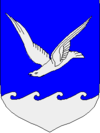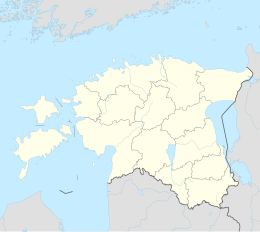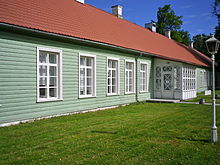Kärdla
| Kärdla | |||
|
|||
| State : |
|
||
| Circle : | Hiiu | ||
| Founded : | before 1564 | ||
| Coordinates : | 59 ° 0 ′ N , 22 ° 45 ′ E | ||
| Area : | 4.5 km² | ||
| Residents : | 3,050 (December 31, 2011) | ||
| Population density : | 678 inhabitants per km² | ||
| Time zone : | EET (UTC + 2) | ||
| Telephone code : | (+372) 46 | ||
| Postal code : | 92401-92420 | ||
| Community type: | city | ||
| Mayor : | Reili Rand
( SDE ) |
||
| Postal address : | Keskväljak 5a 92413 Kärdla |
||
| Website : | |||
|
|
|||
Kärdla (German Kertel , Swedish Kärrdal ) is the only town on the second largest Estonian island, Hiiumaa (German and Swedish Dagö ). It is the capital and administrative seat of the district of Hiiu ( Hiiu maakond ) and the rural community of Hiiumaa of the same area .
Location and population
Kärdla is located on the northeast coast of the island Hiiumaa, directly on the Baltic Sea . The city borders the Tareste bay ( Tareste laht ). The small river Nuutri ( Nuutri jõgi ) and the streams Kammioja and Liivaoja flow through Kärdla .
The name of the city comes from Swedish . Kärrdal describes a swampy and humid valley.
The city has 3,050 inhabitants (as of December 31, 2011). The population is almost entirely Estonian-speaking .
history
Sweden
In 1564 the village of Kärtillby was first mentioned in a document. Its inhabitants were Swedes . They probably immigrated to the island of Hiiumaa from the Swedish-speaking areas of Finland as early as the 14th century .
In 1470, the Livonian order master Johann Wolthus von Herse granted the Hiiumaa Swedes extensive privileges, including exemption from serfdom .
The plague raged on Hiiumaa in the 18th century . Numerous residents of Kärdla also fell victim to it. By 1810 there were almost no Swedish residents in Kärdla. The place was named Kertelhof to Beigut of Partsi ( Pardas ). At first he led a shadowy village existence.
Cloth factory
Kärdla owes its upswing to the establishment of the cloth factory K. u. E. Ungern-Sternberg on the Suuremõisa (German Großenhof ) estate in 1829. Founders were the Baltic German nobles Peter Ludwig Konstantin von Ungern-Sternberg (1779–1836) and Heinrich Georg Eduard von Ungern-Sternberg (1782–1861) with financial support of the Tallinn trading house Clayhills & Co.
As early as 1830, the production with its 210 workers was transferred from the estate to Kärdla. After a fire in 1870, the factory was modernized and rebuilt. There were also numerous houses for the workers. The so-called Dago-Kertelsche Cloth Factory from 1874 was one of the oldest and largest cloth mills in all of Estonia. It was known for its excellent quality. In the 1880s, the company, which was called Hiiu-Kärdla Kalevivabriku Osaühisus from 1918 , employed over 700 workers. The corporation was by far the largest employer in the area.
From 1860 to 1883 a large machine factory and other industrial companies were also active in Kärdla. In 1849 the port of Kärdla was launched. It was destroyed during World War II and has not yet been rebuilt.
20th century
The textile factory was nationalized in December 1940 with the Soviet occupation of the country. Most of the historic factory buildings were destroyed by the Red Army in October 1941 during the German attack on the Soviet Union .
Some workers' houses and the office of the former director are still preserved. A memorial has been in memory of the factory since 1982. It comes from the Estonian sculptor Mati Karmin (* 1959).
In 1920 Kärdla became a large village ( alevik ). On May 1, 1938, Kärdla was granted city rights as part of the Estonian municipal reform.
During the Second World War , Kärdla was subjected to heavy air raids and was badly damaged. Most industrial companies, the port and numerous residential buildings fell victim to the attacks.
Kärdla today
In 2013, Kärdla and the rural community of Kõrgessaare merged to form the rural community of Hiiu , which merged with the other three rural communities on the island to form the rural community of Hiiumaa in 2017 .
Today Kärdla is a green town with small wooden houses and numerous gardens. The cityscape is characterized by the proximity to the Baltic Sea, the natural watercourses and the two parks. The 5.1 hectare Linnapark (“city park”) and the 4.2 hectare Rannapark (“beach park”) are popular meeting places for the city's population.
The Rannapark is located on the site of the former cemetery of the Swedish-speaking population of Kärdla, which existed until 1838. Behind it is the Kärdla bathing beach. There is a large boulder near the beach, near the mouth of the Nuutri River in the Baltic Sea .
Behind the Linnapark is the new Kärdlas cemetery. It was created in the middle of the 19th century. The tourist information office is now located in the former fire station on the central market square in Keskväljak .
Kärdla is the only town on Hiiumaa Island. It is the administrative, economic and cultural center of the island. The only high school Hiiumaas and the hospital on the island are located in Kärdla. The cultural center is well known with its puppet theater founded in 1991 and the central library on the island of Hiiumaa.
Johanniskirche
Swedish farmers built the first chapel in Kärdla. It was dedicated to St. Olav . The year it was created is not known. The chapel stood on the edge of the old Swedish cemetery of Kärdla. It was leveled along with the chapel in 1848 to make way for the beach park.
In 1847, at the instigation of the then director of the cloth factory, Robert von Ungern-Sternberg, the so-called “German Chapel” was built from wood on the banks of the Nuutri . It is no longer preserved today.
Between 1861 and 1863 a larger stone church was built. The simple three-nave church in neo-Gothic style was jointly financed by donations from the workers and the Baltic German nobility Hiiumaas. The Evangelical Lutheran Church has 600 seats. It is dedicated to John the Baptist .
The altar painting "Christ on the Cross" comes from an unknown Baltic German painter. It was erected in 1889. The organ is a work by the South German company Walcker from 1904.
In 1929 the high wooden tower was added. The original bell was melted down by the tsarist authorities in 1917 during the First World War . Today's bell is a gift from businessman Richard Devid . He was born in Kärdla in 1893 and owned, among other things, the Tallinn luxury hotel and restaurant Kuld Lõvi ("Golden Lion"). Devid was deported to the interior of Russia with the Soviet occupation of Estonia and sentenced to death by the Soviet authorities in 1942.
Hiiumaa museum
The Hiiumaa muuseum , founded in Kassari in 1967 and transferred to Kärdla in 1998, provides information about the history of the city and the island . It is located in the "Long House" ( Pikk maja ) built in 1830 for the director of the cloth factory , which is over 60 m long Wooden house Kärdlas.
The museum maintains collections in the fields of natural history, ethnography, archeology, history, numismatics and textile studies. The museum also has an extensive photo collection.
Branch offices of the Hiiumaa museum are the local history museum in the village of Kassari on the neighboring island of the same name, the museum farm Mihkli talu in Malvaste and the museum on the life and work of the composer Rudolf Tobias in Selja .
Airport
Four kilometers east of Kärdla, in the area of the village of Hiiessaare, is the city's airport, Kärdla lennujaam . It was built in 1963. The runway is 1520 m long. From there, machines run daily to the Estonian capital Tallinn and back.
Partnerships
-
 Norrtälje (since 1989)
Norrtälje (since 1989) -
 Pargas (since 1990)
Pargas (since 1990) -
 Sillamäe (since 2002)
Sillamäe (since 2002) -
 Office Neukloster-Warin (since 2006)
Office Neukloster-Warin (since 2006)
sons and daughters of the town
- Heiki Nabi (* 1985), wrestler
- Eveli Saue (* 1984), biathlete
- Erkki-Sven Tüür (* 1959), composer
Impact crater at Kärdla
About 450 million years ago a meteorite crashed near Kärdla . This created a meteorite crater 7 km in diameter. The crater is between 400 and 500 meters deep. The rim wall of the crater can be seen clearly in Paluküla and Tubala. An observation platform for the crater has also been built in Paluküla. There is a small limestone quarry near the platform with an outcrop of cracked limestone.
literature
- Baltic historical local dictionary. Part 1: Estonia (including Northern Livonia). Started by Hans Feldmann . Published by Heinz von zur Mühlen . Edited by Gertrud Westermann . Cologne, Vienna 1985 (= sources and studies on Baltic history. Volume 8/1), ISBN 3-412-07183-8 , pp. 219f.
Web links
- Official website
- Description of the place (Estonian)
- Hiiumaa Museum (Estonian and English)
Individual evidence
- ↑ Archived copy ( memento of the original from February 25, 2018 in the Internet Archive ) Info: The archive link was inserted automatically and has not yet been checked. Please check the original and archive link according to the instructions and then remove this notice.
- ↑ http://www.hiiumaa.ee/tuletorn/german.php?id=6
- ↑ http://pub.stat.ee/
- ↑ et: Hiiu-Kärdla kalevivabrik
- ↑ Archived copy ( Memento of the original from March 18, 2011 in the Internet Archive ) Info: The archive link was inserted automatically and has not yet been checked. Please check the original and archive link according to the instructions and then remove this notice.
- ↑ Archived copy ( memento of the original dated February 7, 2015 in the Internet Archive ) Info: The archive link was inserted automatically and has not yet been checked. Please check the original and archive link according to the instructions and then remove this notice. Retrieved February 7, 2015








